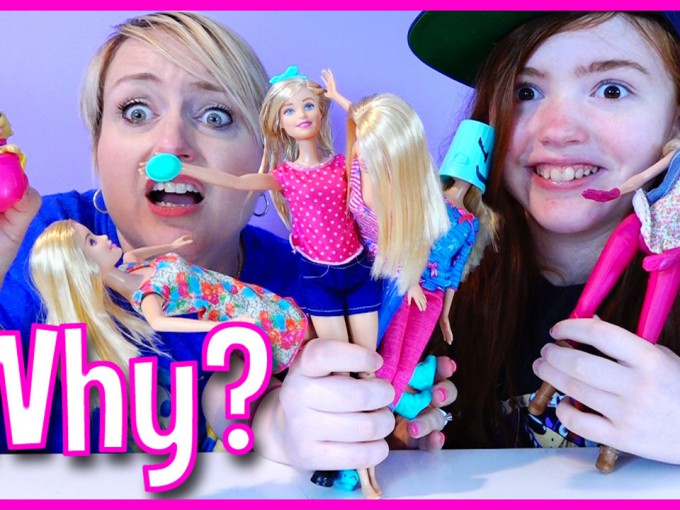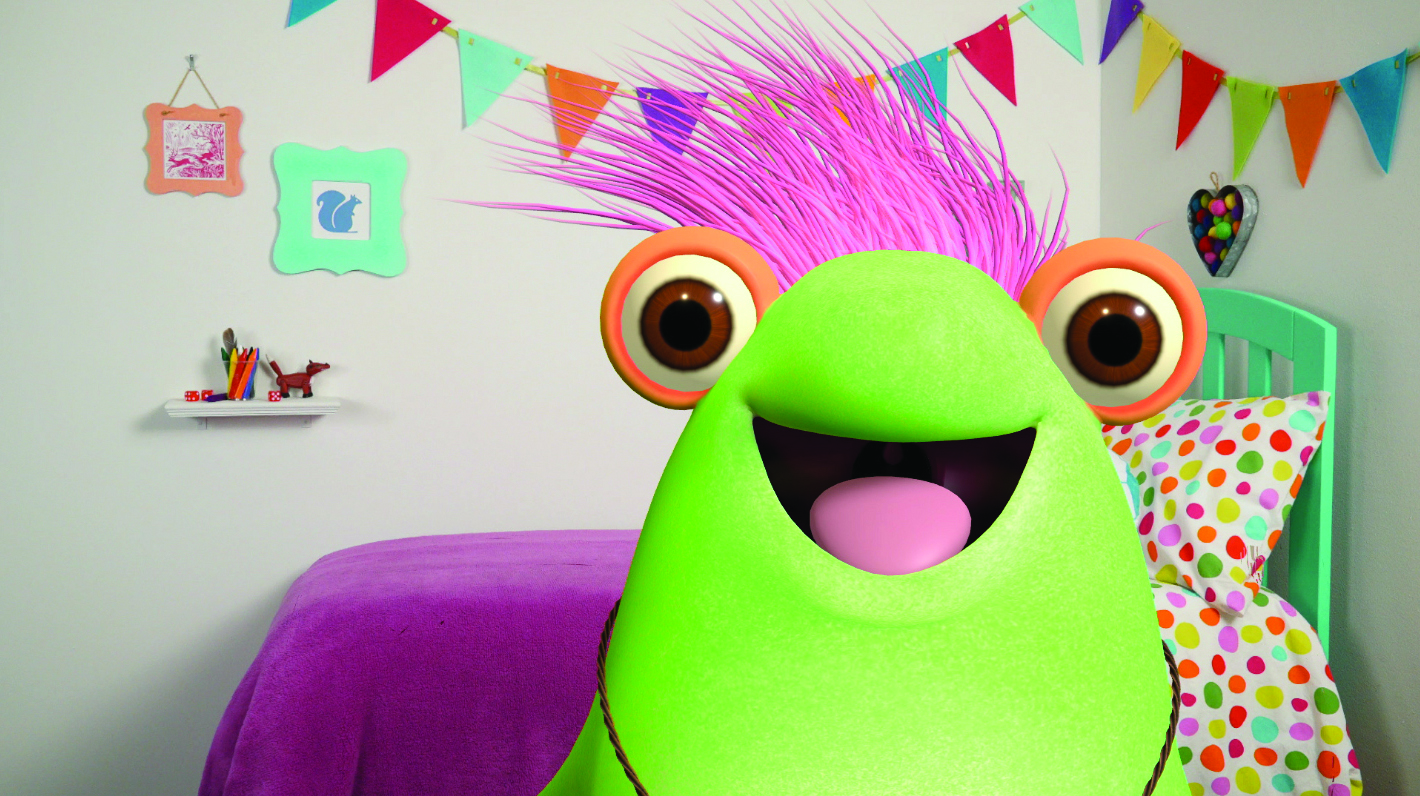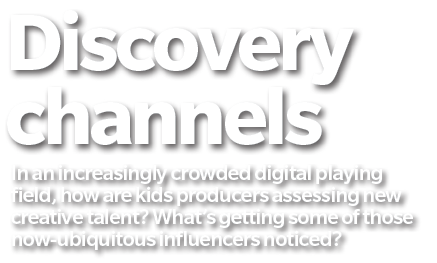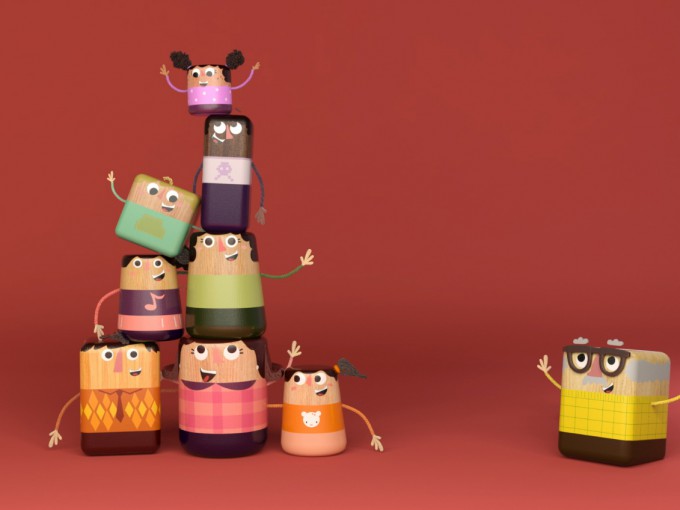The digital age has significantly reduced the barriers to entry for creatives, and that’s opening up huge opportunities for producers to work with a new generation of online influencers. But with so many players now in the game, how do creatives stand out? Kidscreen talks to producers in the biz and the influencers they’re courting, and examines how the market has changed the game.
Part I: The producers
When it comes to finding talent in the digital age, we’re suffering from an embarrassment of riches. It only makes sense that brands and media outlets are increasingly turning to digital platforms—especially YouTube—to discover new creatives and influencers. It’s a crowded and tumultuous field, one full of opportunities and pitfalls, but one of the biggest issues for creatives is simply getting noticed.
“I’d say that a creator’s biggest challenge lies in increasing competition,” observes Birk Rawlings, head of DreamWorksTV. “Digital platforms have reduced traditional barriers to entry, making it that much harder to cut through the noise. The flip side of that, however, is the increased opportunity that these same platforms have opened up for creators with varying experience and backgrounds to bring their projects to a global audience.”
Rawlings describes DreamWorksTV as platform-agnostic, seeking out its audience and creatives wherever they congregate—YouTube, Verizon’s Go90, Comcast’s Watchable and Toca Boca’s TocaTV—but the lineup is constantly evaluated.
“There are certainly more things to look at,” agrees Kay Wilson Stallings, SVP of content development at Sesame Workshop. “But now we are hearing from creators who normally might not have received an opportunity to get in front of a network executive. So it takes a little longer because you have more options, but you are really discovering people who have a distinct and fresh point of view.”
The Workshop launched its Sesame Studios YouTube channel back in May, and has since posted three original pieces of content per week—songs, stories, mixed media, animation and live action. “It’s really like a giant sandbox,” she says. “We’re able to tap into a lot of creative talent we might not necessarily have been able to tap into otherwise.”
Wilson Stallings says Sesame Studios is literally working with everyone—from creators still in college, to experienced producers. If they lack industry experience, Sesame surrounds them with a team for support. The outlet takes submissions on its website (sesamestudios.com) 24/7, but it also puts out RFPs and throws the doors open to creative talents with either a fully fleshed-out concept or just ideas and drawings.
And while the world may have grown, it’s also gotten a lot faster, which can be an added complication. “The timeframe in terms of production is much quicker,” she notes. “We can put out the RFP, and in four months or less if it is live action, we can have something uploaded to the channel.”
However, it doesn’t change the ask. “We are still looking for characters that are timeless. We’re not really looking for something that can be just in and out, because once it is uploaded it lives forever. We want to make sure the content has legs and can sustain itself for repeated views.”
Netflix is similarly careful to avoid the digital flash in the pan. “I think that time to market on digital platforms tends to be much quicker,” notes director of global kids content Andy Yeatman. “And obviously that enables fads to pop up very quickly and maybe fade very quickly. But that’s definitely not something we are chasing at Netflix,” he says. “We want to find content that will be just as compelling one or five years from now as it is next week. So that’s definitely something we take into account when we’re looking at content we’re commissioning.”
Yeatman says Netflix is looking for exclusive content and individual storytelling. “For us, it is talent—that unique point of view—and a distinctive story that isn’t told on other platforms,” he says. “So it’s not really different than when we are looking at stories from any other source: Do we think that this show has characters that will resonate with the audience, that the audience will relate to and find aspirational? And do we think there is an interesting story that will sustain their interest over the course of one and hopefully many seasons?”
Part II: The influencers
Most online influencers—at least those with a following who’ve been around for a while—are not babes in the digital woods. “They definitely they see themselves as brands,” says Dylan Collins, CEO of London-based kids advertising and marketing agency SuperAwesome. “They have a very strong awareness of the value of their followers and their audience,” he adds. “I think what you also see, certainly in the last two or three years, has been the emergence of this consciousness that they need to use their powers for good. Influencers are very aware of how they use their fame, and how they use their subscriber base to work with brands.”

Presley Alexander hosts the ActOutGames channel on YouTube, tackling everything from science to Japanese for young YouTubers
On the digital dial—ActOutGames
Brian Alexander helps run the ActOutGames YouTube channel for his daughter, Presley. They launched in June 2013.
Presley had grown up on the platform, and her heroes had been YouTubers—especially vloggers like Charles Trippy and the Shaytards. So when the Alexanders found themselves with another child on the way, Brian offered to take then six-year-old Presley on a last daddy-daughter trip anywhere in the US before the baby was born. Without hesitation, she chose VidCon, the SoCal video conference started by Hank and John Green of the Vlogbrothers fame.
“I didn’t even know what VidCon was at the time,” says Alexander. “So she had to explain to me that it was this YouTube conference, and she wanted to meet these YouTubers. And I said, ‘That’s awesome, let’s go do that.'”
But Presley didn’t want to be an outsider. She wanted to go as a legitimate YouTuber. So 50 days before the event, they started a daily video channel. Three years later, they’ve yet to miss a day, and ActOutGames has nearly 19,000 subscribers and more than 2.8 million views. Like many YouTubers, Presley is home-schooled. So her educational channel serves as a barometer of lessons learned. “If she can make a video about how to conjugate a Japanese verb or explain what buoyancy means,” observes her dad, “then I know she understands it very well.”
Although her channel is relatively small compared to some, Presley has found a solid educational niche. For the past two years she has been on panels at VidCon, given a talk at YouTube, done work for DreamWorksTV, and taken part in plenty of collabs (collaborations) with other YouTubers. She’s also now working on a digital series pilot for PBS KIDS.
“It’s all about being open to opportunities that come up,” Alexander explains. “Presley has final say on whatever happens. We sit down as a family and we talk to her about it and gauge her comfort level. If she is comfortable, then we slowly move forward. And whenever she gets uncomfortable, we pull back and don’t do it anymore. It is just a matter of letting her try some things out and see what she likes and what she doesn’t.”
The Alexanders eschew most review vids and are careful with whom they partner. They have even avoided an agent to this point. Says dad, “That’s one of those tipping-point things that we are not sure we are quite ready for. If you do that, you’re committing. That person is going to be out there hustling, trying to get you work, trying to line things up and get things done. Fifty percent of that sounds great, and 50% of it sounds horrifying.”
The Alexanders are more comfortable taking it one day at a time. “It is just too early to say: ‘OK, we are going to do this and we have this five-year plan for Presley. In two years she is going to be hosting her own show, and in four years she is going… That’s just crazy to talk about for an 11-year-old.”
For now, it’s about staying on point. Because it’s primarily a science and education channel, the family spends a lot of time doing research, talking to experts and getting the science right. They also have to be extra careful—for example, they carry E&O insurance, as Presley demonstrates science experiments.
“You have to protect yourself,” he cautions. “These are things that you would never think about, but as she gets bigger and people start to recognize her, they are things you have to take seriously.”
As a digital creator, he says it’s a fine balance. While it eventually turns into a business, that can’t be why you do it. “You have to love it,” he asserts. “You see people that come in thinking, ‘Hey, we are going to make a ton of money,’ or ‘We are going to get all these free toys,’ and you know that they are going to come and go over the next couple of months when it doesn’t happen that way. If we weren’t making any money at all, if we weren’t getting any brand deals, if we weren’t doing anything, we would still be doing exactly what we are doing.”

Melissa Hunter and daughter Gracie are the hosts of the Mommy and Gracie Show, which has already attracted more than 700,00 YouTube subscribers
On the digital dial—Mommy and Gracie Show
Melissa Hunter is the Mommy half of the Mommy and Gracie Show. Launched in June 2012, the channel has nearly 700,000 subscribers and almost 400 million views.
It was Gracie’s idea, says Hunter. Then an eight-year-old facing the end of the school year with no real plans, Gracie wanted to start a YouTube channel—they would review Monster High dolls, and follow the example of YouTubers they loved to watch. Hunter says things were distinctly low-tech at the start—they shot videos on her laptop camera. But they have uploaded new content six days a week since launch, and although the channel has grown exponentially, Hunter says they refuse to give up their goofball ways.
As a parent, Hunter feels her responsibility to her audience and her daughter very strongly. “YouTube’s stance is that you can’t have an account unless you are 13 years old, and that five-years-olds shouldn’t be watching,” she says. “But the reality is, they are. There are infants watching YouTube.
“We don’t do a lot of sponsored or branded stuff, but when we do, we are extremely transparent. You have to get up in the morning, look at yourself in the mirror and ask if the money is worth doing what you are doing when you know your audience is children.
“This is something I do with my daughter, so I’m always mindful. Certainly, there is that pull inside of me as a competitive person to chase those numbers. But on the other side of it, with everything that I am doing, my daughter is watching. She is a part of this with me. That really keeps me grounded.”
Right now, Hunter has no interest in an agent or moving away from YouTube, as the pair now has full control of everything it does. The constant demand for content is currently the biggest challenge, but she sees others to come. “When you are working with your child, her likes and dislikes change,” Hunter observes. “Now we are in the teenage years, and when they become teenagers they want to go in their room and not come out until they’re 18. I don’t force her to film, so I have to kind of catch her on a day when she is interested, and then we film a whole bunch of stuff.”
But her audience has come along for the ride. “I think what’s happening with us is that our audience is growing up with Gracie. So kids who watched us four years ago are still watching us, but they have grown up too.”
And if Gracie grows up and wants to do her own thing? That’s fine with Hunter, who says she will always have a channel of some kind on YouTube. “It’s more important to me to teach her to be true to herself and to be ethical—to not chase the money but instead to chase the happiness.”
A changing market
The skyrocketing amount of time viewers spend on digital is changing the face of the kids entertainment industry, and partnerships between online creators and offline brands are becoming increasingly more common. Kidscreen sat down with Dylan Collins, CEO of London-based kids advertising and marketing agency SuperAwesome, and its chief commercial officer Paul Nunn, to find out how things are changing.
Brands and channels are obviously looking for influencers with pre-existing audiences, but what else are they looking for?
Paul Nunn: I think the other things they look for are safety, and a deeper understanding of what the commercial message is that’s put across by the influencers on a daily basis. How do you take old-fashioned marketing rules and regulations about how to market products and interact with children—from data privacy all the way through to brand messaging? How do you translate that into a medium that’s constantly shifting, with new platforms exploding all the time, the vast majority of them not for kids under 13?
Dylan Collins: For the most part, technology companies have built platforms with the assumption that no one under 13 is actually on the internet. Turns out, this is not the case. So part of the challenge now for kids digital content owners and brands is not just thinking about how do we engage with kids—through what means, and with what kind of creative—but what are the dedicated kids channels we need to use to do so? Because the great difference is the data privacy laws for under-13s. If you are a digital media company, whether you are a content owner or brand, you spend a huge amount of time thinking about COPPA in the US and GDPR in Europe.
The kids industry is only starting to ramp up on digital. If you look at the average digital spend brands make in the kids sector, it’s probably about 10% of their total budget. The rest is being spent on TV. If you look at in any other sector, 50%, 60% or 70% is pretty common for brand spend on digital. So digital growth in the kids sector is starting to explode, and people are only now starting to grapple with the challenges.
Nunn: Social players will have a huge impact on how content delivery is going to change—even if you consider that underpinning social is really data. The piece that is missing now is data. The kids category is always going to be exempt from that because data is one thing you cannot have—which is why there’s a real juxtaposition between what is happening with kids and what is happening in the general market. It’s why original companies are going to have to spring up.
You have a situation now where a lot of broadcasters, especially ones that are part of the large media groups, have had the luxury of owning content creation and delivery, but now the new world is upon them. I think in some respects, they are still far out in front—but on the distribution front, they are playing frantic catch-up.
Digital influencers can now reach tens of millions of followers—a healthy ‘broadcast’ footprint. But what’s more valuable, sheer numbers or undiscovered talent?
Nunn: If you go back even 10 years, there were huge barriers. Nobody could upload anything to a broadcaster. No one had the resources to create content. Brands didn’t have the wherewithal to create their own content divisions because the barriers were enormous. Cut to now, and those barriers get smaller every day.
I think broadcasters are definitely looking at the up-and-coming rather than the established—the creators that are on the newest platform and starting to build an audience. But from the advertiser and brand side, more established stars are going to give you that audience and are going to give a cut-through for your brand message from the very start.
But when we take a kids content view of that, it is quite a different picture because there are loads landmines for brands that work with creators and influencers in this space. It’s very rare that you would get what we would describe as a completely ‘clean slate’ influencer, one who has never posted a video with some swearing or something inappropriate in it. It becomes a bit more of a conversation to have when you get to the tween-targeted stuff, but certainly in the kids area it is a minefield, which is why we have done a lot of work to try and source the right creators and the right influencers.
How are partnership timelines changing in the new order?
Nunn: Partnerships tend to be on short to medium terms, just like an advertising campaign. A brand will go through different cycles that they choose, the messaging that they choose, and so it is definitely about finding what could communicate their brand message right now. But that being said, a lot of them are moving into ambassador territory, and that is more along the lines of a sport sponsorship, where you have a long-running connection with your audience through that ambassador
Collins: As the budgets are increasing, there is a greater opportunity for proper sophistication on both the side of the brand and the content creator. I think we have seen the first wave or the first couple of waves of how this plays out, and as more specialist tools are starting to emerge, that is going to allow younger content creators to build out a different type of opportunity. It is going to allow brands to do different things
Nunn: I would also say that one of these shifts that I believe we will see in the next three to five years is how to harness the huge depth that is the middle tier of YouTube creators. There have been countless entries to the market over the last six years—smaller animation studios, vloggers and family vloggers, gaming channels, fun channels that just sprouted from nowhere. That middle tier is getting bigger and bigger.



























